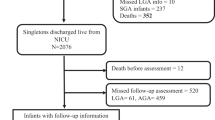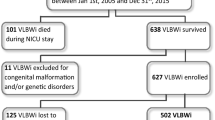Abstract
Objective
Investigate neurodevelopmental outcomes at 3 years corrected age in infants with a birth weight ≤1250 g born to single parents.
Study Design
Infants born between 1995 and 2010 with a birth weight ≤1250 g were considered eligible. Primary outcome was neurodevelopmental impairment; considered present if a child had any of the following: cerebral palsy, cognitive delay, visual impairment, or deafness/neurosensory hearing impairment. Univariate and multivariate analyses were performed.
Result
A total of 1900 infants were eligible for inclusion. Follow-up data were available for 1395; 88 were born to a single parent. Infants in the single-parent group had higher mortality (18% vs. 11%, p = 0.009), IQ ≥1 SD below the mean (40% vs. 21%, p = 0.001) and any neurodevelopmental impairment (47% vs. 29%, p = 0.003). Single-parent family status, maternal education, bronchopulmonary dysplasia and severe neurological injury were significant predictors of intellectual impairment at 3 years corrected age.
Conclusion
Preterm infants with a birth weight ≤1250 g born to single parents at birth have poorer intellectual functioning at 3 years corrected age.
This is a preview of subscription content, access via your institution
Access options
Subscribe to this journal
Receive 12 print issues and online access
$259.00 per year
only $21.58 per issue
Buy this article
- Purchase on Springer Link
- Instant access to full article PDF
Prices may be subject to local taxes which are calculated during checkout


Similar content being viewed by others
References
Hayes B, Sharif F. Behavioural and emotional outcome of very low birth weight infants--literature review. J Matern Fetal Neonatal Med. 2009;22(10):849–56.
Manley BJ, Roberts RS, Doyle LW, Schmidt B, Anderson PJ, Barrington KJ, et al. Social variables predict gains in cognitive scores across the preschool years in children with birth weights 500 to 1250 grams. J Pediatr. 2015;166(4):870–6. e871–872.
McCormick MC. The contribution of low birth weight to infant mortality and childhood morbidity. N Engl J Med. 1985;312(2):82–90.
Avan B, Richter LM, Ramchandani PG, Norris SA, Stein A. Maternal postnatal depression and children’s growth and behaviour during the early years of life: exploring the interaction between physical and mental health. Arch Dis Child. 2010;95(9):690–5.
Miceli PJ, Goeke-Morey MC, Whitman TL, Kolberg KS, Miller-Loncar C, White RD. Brief report: birth status, medical complications, and social environment: individual differences in development of preterm, very low birth weight infants. J Pediatr Psychol. 2000;25(5):353–8.
Kang G, Lim JY, Kale AS, Lee LY. Adverse effects of young maternal age on neonatal outcomes. Singap Med J. 2015;56(3):157–63.
Laucht M, Esser G, Schmidt MH. Developmental outcome of infants born with biological and psychosocial risks. J Child Psychol Psychiatry. 1997;38(7):843–53.
McLanahan S, Sandefur G. Growing Up with a Single Parent. What Hurts, What Helps. Harvard University Press, 79 Garden Street: Cambridge, MA, 1994.
U.S Census Bureau: America’s Families and Living Arrangements Table Package. https://www.census.gov/newsroom/press-releases/2016/cb16-192.html; 2017.
Bloome D. Childhood family structure and intergenerational income mobility in the United States. Demography. 2017;54(2):541–69.
Statistics Canada 2017. Census in Brief: Portrait of children’s Family Life in Canada in 2016. http://www12.statcan.gc.ca/census-recensement/2016/as-sa/98-200-x/2016006/98-200-x2016006-eng.cfm; 2017.
Colton T, Janzen B, Laverty W. Family structure, social capital, and mental health disparities among Canadian mothers. Public Health. 2015;129(6):639–47.
Clarke TC, Arheart KL, Muennig P, Fleming LE, Caban-Martinez AJ, Dietz N, et al. Health care access and utilization among children of single working and nonworking mothers in the United States. Int J Health Serv. 2011;41(1):11–26.
Blondel B, Zuber MC. Marital status and cohabitation during pregnancy: relationship with social conditions, antenatal care and pregnancy outcome in France. Paediatr Perinat Epidemiol. 1988;2(2):125–37.
Doucet H, Baumgarten M, Infante-Rivard C. Low birth weight and household structure. J Dev Behav Pediatr. 1989;10(5):249–52.
Hanke W, Kalinka J, Sobala W. Single motherhood, urban residence and SGA babies in Central Poland. Int J Gynaecol Obstet. 1998;61(3):289–91.
Huhtala M, Korja R, Lehtonen L, Haataja L, Lapinleimu H, Rautava P, et al. Parental psychological well-being and behavioral outcome of very low birth weight infants at 3 years. Pediatrics. 2012;129(4):e937–944.
Kilbride HW, Thorstad K, Daily DK. Preschool outcome of less than 801-gram preterm infants compared with full-term siblings. Pediatrics. 2004;113(4):742–7.
Bronson SL, Bale TL. The placenta as a mediator of stress effects on neurodevelopmental reprogramming. Neuropsychopharmacology. 2016;41(1):207–18.
Soleimani F, Zaheri F, Abdi F. Long-term neurodevelopmental outcomes after preterm birth. Iran Red Crescent Med J. 2014;16(6):e17965.
Hack M, Klein NK, Taylor HG. Long-term developmental outcomes of low birth weight infants. Future Child. 1995;5(1):176–96.
Hollingshead A. Four-factor index of social status. Yale University: New Haven, CT, 1975.
CNN Abstractor’s Manual v.3.0.0 (released January 2017). http://www.canadianneonatalnetwork.org/Portal/LinkClick.aspx?fileticket=h4VXdWoqMNM%3d&tabid=69. Toronto: The Canadian Neonatal Network; 2017.
Shennan AT, Dunn MS, Ohlsson A, Lennox K, Hoskins EM. Abnormal pulmonary outcomes in premature infants: prediction from oxygen requirement in the neonatal period. Pediatrics. 1988;82(4):527–32.
Papile LA, Burstein J, Burstein R, Koffler H. Incidence and evolution of subependymal and intraventricular hemorrhage: a study of infants with birth weights less than 1,500 gm. J Pediatr. 1978;92(4):529–34.
An international classification of retinopathy of prematurity. The committee for the classification of retinopathy of prematurity. Arch Ophthalmol. 1984;102(8):1130–4.
Bell MJ, Ternberg JL, Feigin RD, Keating JP, Marshall R, Barton L, et al. Neonatal necrotizing enterocolitis. Therapeutic decisions based upon clinical staging. Ann Surg. 1978;187(1):1–7.
Fenton TR, Kim JH. A systematic review and meta-analysis to revise the Fenton growth chart for preterm infants. BMC Pediatr. 2013;13:59.
Palisano R, Rosenbaum P, Walter S, Russell D, Wood E, Galuppi B. Development and reliability of a system to classify gross motor function in children with cerebral palsy. Dev Med Child Neurol. 1997;39(4):214–23.
Behere AP, Basnet P, Campbell P. Effects of family structure on mental health of children: A Preliminary Study. Indian J Psychol Med. 2017;39(4):457–63.
Youngblut JM, Brooten D, Singer LT, Standing T, Lee H, Rodgers WL. Effects of maternal employment and prematurity on child outcomes in single parent families. Nurs Res. 2001;50(6):346–55.
Ahmed F. Unmarried mothers as a high-risk group for adverse pregnancy outcomes. J Community Health. 1990;15(1):35–44.
Voss W, Jungmann T, Wachtendorf M, Neubauer AP. Long-term cognitive outcomes of extremely low-birth-weight infants: the influence of the maternal educational background. Acta Paediatr. 2012;101(6):569–73.
Eriksen HL, Kesmodel US, Underbjerg M, Kilburn TR, Bertrand J, Mortensen EL. Predictors of intelligence at the age of 5: family, pregnancy and birth characteristics, postnatal influences, and postnatal growth. PLoS ONE. 2013;8(11):e79200.
Hernandez A, Aguilar C, Paradell E, Munoz MR, Vannier LC, Vallar F. The effect of demographic variables on the assessment of cognitive ability. Psicothema. 2017;29(4):469–74.
Siegel LS. Reproductive, perinatal, and environmental factors as predictors of the cognitive and language development of preterm and full-term infants. Child Dev. 1982;53(4):963–73.
Siegel LS, Saigal S, Rosenbaum P, Morton RA, Young A, Berenbaum S, et al. Predictors of development in preterm and full-term infants: a model for detecting the at risk child. J Pediatr Psychol. 1982;7(2):135–48.
Treyvaud K, Inder TE, Lee KJ, Northam EA, Doyle LW, Anderson PJ. Can the home environment promote resilience for children born very preterm in the context of social and medical risk? J Exp Child Psychol. 2012;112(3):326–37.
Ackerman JP, Riggins T, Black MM. A review of the effects of prenatal cocaine exposure among school-aged children. Pediatrics. 2010;125(3):554–65.
Hunt RW, Tzioumi D, Collins E, Jeffery HE. Adverse neurodevelopmental outcome of infants exposed to opiate in-utero. Early Hum Dev. 2008;84(1):29–35.
Khatun M, Al Mamun A, Scott J, William GM, Clavarino A, Najman JM. Do children born to teenage parents have lower adult intelligence? A prospective birth cohort study. PLoS ONE. 2017;12(3):e0167395.
Author contributions
A.K.L. made substantial contributions to research design, acquired, analyzed and interpreted the data; helped draft the paper, revised it critically and approved the submitted and final versions. J.L., K.E., A.r.L. and V.G. helped to collect data, draft and revise the manuscript and approved the submitted and final versions. S.T. analyzed and interpreted the data and approved the submitted and final versions of the manuscript. D.C. interpreted psychological data, and critically revised and approved the manuscript.
Author information
Authors and Affiliations
Corresponding author
Ethics declarations
Conflict of interest
The authors declare that they have no conflict of interest.
Rights and permissions
About this article
Cite this article
Lodha, A., Lakhani, J., Ediger, K. et al. Do preterm infants with a birth weight ≤1250 g born to single-parent families have poorer neurodevelopmental outcomes at age 3 than those born to two-parent families?. J Perinatol 38, 900–907 (2018). https://doi.org/10.1038/s41372-018-0118-7
Received:
Revised:
Accepted:
Published:
Issue Date:
DOI: https://doi.org/10.1038/s41372-018-0118-7



